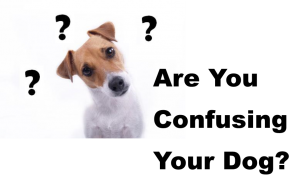© 2014 Jerry D. Patillo, CPDT-KA, Phoenix Behavior Consulting
If you want to avoid confusing your dog, make sure everything you say to your dog means one thing and only one thing, each and every time. E.g., when you say your dog’s name, what does its name mean to YOU?
- Look at me?
- Come to me?
- Get off the couch?
- Stop barking?
- Let go of the cat?
What does your dog’s name mean – REALLY mean – to your dog? How did you teach your dog what its name really means? No wonder your dog’s confused. It’s not being stubborn or rebellious. It just doesn’t have a clue what you want.
Another example: What does “Down” mean to YOU?
- Get off Grandma?
- Lie down on top of Grandma?
- Get off the couch?
- Lie down on top of the couch?
What does “Down” mean to your dog? How did you teach it what “Down” means? Make sure everything you – AND your family – say to your dog, verbally and visually, means the same thing each and every time.
It’s all about consistency. We want the word “Down” to mean “Lie down on the floor or at least the surface below you.” We want “Off” to mean “Put your feet back onto the floor!”
Here’s one way to make it easier to be consistent. Make a glossary of your dog’s behaviors. Make a list of your dog’s verbal and visual cues (prompts or commands) and define each one. Describe what you always want your dog to do for each cue.
For example, here’s a sample chart you can do on your computer or by hand:
| Verbal Cue | Visual Cue | Description |
|---|---|---|
| “Watch me” | “Look at me” or “Give me your attention” | |
| “Sit” | Extend your hand out with your palm up. Lift your hand upward a few inches. | “Put butt on floor” (or surface below you) |
| “Down” | Put your fist out in front of you with the forefinger extended. Bring your fist downward and point toward the floor. | “Put elbows and hocks on floor” (or surface below you) |
| “Off” | Put your fist out in front of you with the forefinger extended. Sweep your fist with extended forefinger to the side and point toward the floor. | “Take your feet off what they’re on right now and put them onto the floor.” (E.g., take your feet off me, off the couch, off the kitchen counter, and put them back onto the floor.) |
| “Stay” | Put your open palm outward toward your dog, like a “stop” signal from a policeman. | “Maintain this bodily position (Sit, Down, Stand, etc.) until I release you.” |
| “Wait” | When you’re facing your dog, same as “Stay.” When you and your dog are facing same direction, lower your open palm to your dog’s face. | “Stop forward motion until I release you. (I don’t care what your bodily position is while you’re waiting.)” |
| etc. | etc. | etc. |
The verbal cue in the chart above is the spoken prompt or command that you give to your dog to elicit a behavior. E.g., saying “Sit” prompts the dog to put its cute little butt on the floor or the surface below it.
The visual cue is the hand signal or other visual stimulus that gets the dog to do the behavior you want. E.g., extending your palm out facing upward and lifting your hand upward a few inches gets your dog to “Sit.”
The description above is an explanation of the behavior you want your dog to do.
EVERYONE in your household should work with training your dog. However, only one person should be in charge of training. That one person should be in charge of training everyone else in the household how to work with the dog. Everyone in your house should work with the dog the same way, each and every time. Otherwise, your dog will be confused and won’t have a clue about what is expected. A glossary of your dog’s cues and behaviors, such as the chart exemplified above, will help you to introduce and maintain consistency in your dog’s training and behaviors.
If you need help teaching consistency in your household, please call us today! We can help you prevent other members of the family or household from undoing your training efforts. Our training schedule fills up quickly. Call us today!
